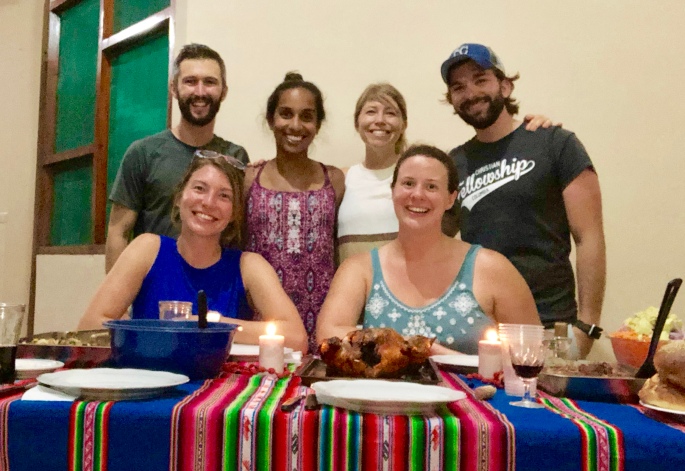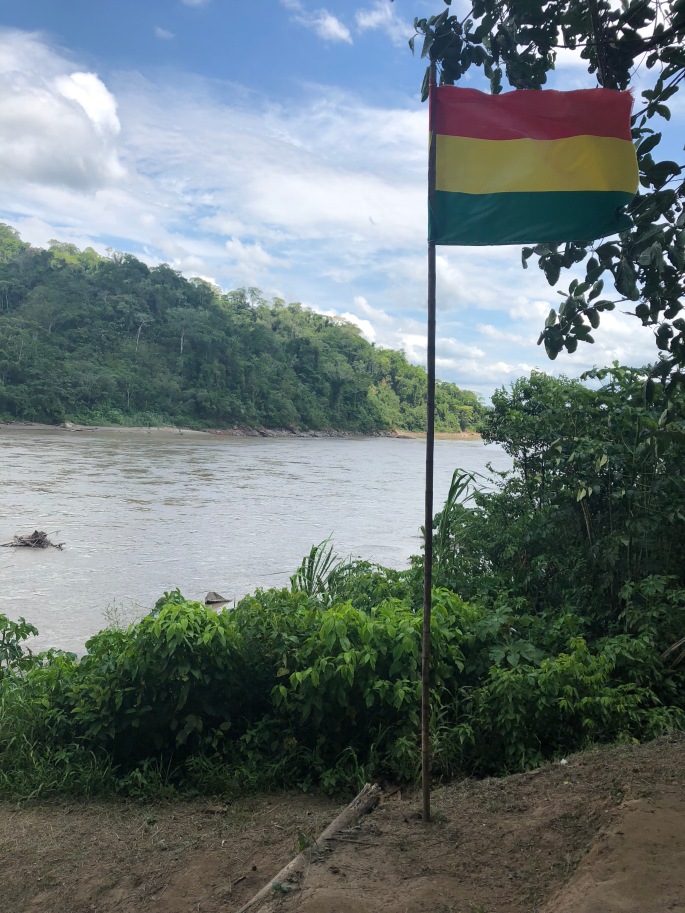It’s strange to think that two years have passed since Jane and I started having conversations about me going on an international rotation. More than that if you consider the fact that I was applying to PA schools three to four years ago and picking out those that boasted well-established international rotations. And now it’s done. The hospital, the apartment, Luz de Mar (the go-to spot for lunch), the rickety boat ride across the river, the obnoxious late-night karaoke, the hike to the cross… they’re memories now.
The only two ways out of Rurrenabaque are to either take a thirty minute, twenty-passenger plane to La Paz or take a sixteen-hour bus ride through the mountains across roads so narrow and close to the edge that you won’t find a local that would recommend it. Even though we spent the better half of the day before we left fighting with the airline, it was worth it to avoid the latter. It meant, however, that we had an eighteen hour lay-over in La Paz. After exploring the city, it quickly became obvious that we made the right choice.
La Paz sits at over 12,000 feet elevation, nestled in a valley within the Andes mountains. The location was originally chosen for its strategic location between Lima, Peru and trade to the east. Today, however, it’s marveled more for its unique 360-degree mountain view. Their public transportation consists of a very confusing and overwhelming bus system (that got Nikki and I lost for thirty minutes before finally finding Nicole) and the Teleférico. The Teleférico, an aerial cable car system that looks like a ski left, functions much like subways do in major cities across the world. This system, however, not only surely saved the city loads of money in construction and operations, but additionally offers its users breath-taking views of the city and the surrounding mountains.
Touring La Paz was a great way to cap off the rotation, and an experience that deserves more than an eighteen-hour lay-over.
A week prior to leaving, we got together with an American couple we met in Rurrenabaque for a thanksgiving meal. Steve and Lisa are spending a year in Rurrenabaque working with an engineering company that provides water restoration for small, rural communities. During our meal (which despite the fact that our turkey was actually a chicken, turned out pretty true to a classic Thanksgiving dinner), we took turns sharing what we were thankful for. Everyone had things unique to them, but some resounding themes stuck out.
We were thankful to be eating American food, that we weren’t sleeping in tents that night, and that we had a thanksgiving pie to look forward to after the meal. We were thankful that none of us had (yet) acquired Dengue Fever. We were thankful that we were provided an education and given the opportunity to travel overseas for a rotation. We were thankful for prospective; that we could see how other cultures practiced healthcare, how the people of Bolivia care deeply for one another, and that they seem to do well without the distractions of American technology and luxuries. We were thankful for the hospitality of the people of Bolivia and of their genuine interest in us. We were thankful for the vision that it has given each of us, and the yearning to return to Bolivia or elsewhere to provide healthcare to medically underserved people groups. We were truly thankful for the experience and forever grateful to the people of Rurrenabaque, Bolivia.
¡Gracias por leer!
Cameron





































































































 Nikki and I have been working with Dr. Octavio in the Emergency Department. One of the major differences we’ve noticed, as it would be with any health care system other than one’s own, is that a differential diagnosis must include things that are common to that area. For example, in Bolivia, it is important that before diagnosing someone with a viral cold to consider mosquito-borne illnesses such as Dengue, Malaria, Zika, and Chikungunya. These sometimes-severe illnesses can present with non-descript symptoms that mimic that of a cold. Fever, headache, abdominal pain, fatigue, and weakness are often the presenting symptoms. Such mosquito-borne illnesses are seldom considered in the US but are a part of everyday medicine in Bolivia.
Nikki and I have been working with Dr. Octavio in the Emergency Department. One of the major differences we’ve noticed, as it would be with any health care system other than one’s own, is that a differential diagnosis must include things that are common to that area. For example, in Bolivia, it is important that before diagnosing someone with a viral cold to consider mosquito-borne illnesses such as Dengue, Malaria, Zika, and Chikungunya. These sometimes-severe illnesses can present with non-descript symptoms that mimic that of a cold. Fever, headache, abdominal pain, fatigue, and weakness are often the presenting symptoms. Such mosquito-borne illnesses are seldom considered in the US but are a part of everyday medicine in Bolivia.












































 I honestly had many thoughts early on in clinical year about canceling my trip to Bolivia because of the distance we’d face. We’ve never been apart this long before and saying goodbye for the month was very difficult. Yet we are both confident that me going to Bolivia is the right choice. Many, maybe just several, years from now, I’ll be convincing students to go on a clinical rotation who could be in a similar situation. Everyone has things they’re leaving behind: relationships, American food, Sunday football (I’m actually hopeful I’ll be able to screen games… fingers crossed!) But providing access to medically underserved people-groups sometimes comes with that sacrifice.
I honestly had many thoughts early on in clinical year about canceling my trip to Bolivia because of the distance we’d face. We’ve never been apart this long before and saying goodbye for the month was very difficult. Yet we are both confident that me going to Bolivia is the right choice. Many, maybe just several, years from now, I’ll be convincing students to go on a clinical rotation who could be in a similar situation. Everyone has things they’re leaving behind: relationships, American food, Sunday football (I’m actually hopeful I’ll be able to screen games… fingers crossed!) But providing access to medically underserved people-groups sometimes comes with that sacrifice. e floor next to me in the airport. Who would’ve ever thought altitude sickness was that bad!? (definitely not Nikki and I…). La Paz, the airport we’re currently in, has an altitude of nearly 13,000 feet, which is roughly 13,000 feet more than what we’re used to. Luckily, Rurrenabaque is at a much lower elevation. We should’ve planned for this long of a layover, but oh well… hindsight is 20/20. Pro tip: if you find yourself in a similar predicament, your go-to cocktail should be lots of water, Ibuprofen, and oxygen (you can get oxygen from most pharmacies). And walk slowly! (our first mistake).
e floor next to me in the airport. Who would’ve ever thought altitude sickness was that bad!? (definitely not Nikki and I…). La Paz, the airport we’re currently in, has an altitude of nearly 13,000 feet, which is roughly 13,000 feet more than what we’re used to. Luckily, Rurrenabaque is at a much lower elevation. We should’ve planned for this long of a layover, but oh well… hindsight is 20/20. Pro tip: if you find yourself in a similar predicament, your go-to cocktail should be lots of water, Ibuprofen, and oxygen (you can get oxygen from most pharmacies). And walk slowly! (our first mistake). I think even though we’re exhausted from travel, nauseous, and frustrated, Nikki and I (and most likely the other two students who are also going to Bolivia but are flying separate), are just excited to get started with the rotation. This rotation, and other international rotations, are built on the foundations of students that’ve gone in the past. We’re thankful that that makes our lives easier, but we’re also hopeful that we can make an impact on the community here and inspire and encourage other students to continue building relationships with the people of Rurrenabaque, Bolivia.
I think even though we’re exhausted from travel, nauseous, and frustrated, Nikki and I (and most likely the other two students who are also going to Bolivia but are flying separate), are just excited to get started with the rotation. This rotation, and other international rotations, are built on the foundations of students that’ve gone in the past. We’re thankful that that makes our lives easier, but we’re also hopeful that we can make an impact on the community here and inspire and encourage other students to continue building relationships with the people of Rurrenabaque, Bolivia.